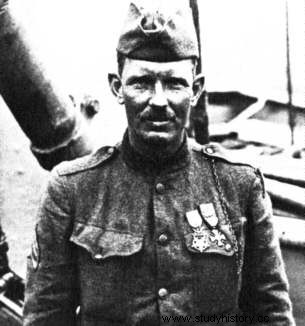While Bullard stalled in front of the Kriemhilde line, Liggett prepared a daring tactical maneuver to relieve the flank of his army.
He assembled the 82nd Division and launched his attack across the Aire valley, capturing the escarpments overlooking the Argonne.
This relieved the pressure on the "lost battalion"; it was, moreover, during this attack that one of the most famous figures of the war in the United States was revealed, Corporal Alvin C. York, of Company G of the 328th Infantry Regiment .

York had been recruited despite his conscientious objection. During his training, this Tennessee mountaineer proved to be an excellent marksman.
On October 8, York was part of a 17-man patrol sent to silence some enemy machine guns.
The patrol had already captured a group of Germans when it was attacked by a larger enemy force. In the ensuing disorder, the American soldiers tried to take cover and guard their prisoners.
Not Corporal York!
York counterattacked alone, with such ferocity that he killed at least fifteen enemy soldiers. Finally 132 Germans including 5 officers surrendered to him.
By October 12, the Americans had assembled enough divisions to constitute two armies. The first was entrusted to Liggett and the second to Bullard. But, even before they could ensure control of operations, Pershing took direct command of the First Army to launch an assault on the Kriemhilde line.
Pershing had, in fact, noticed that the ridge of the Côte Dame Marie, west of Romagna, was a key position. On October 14, he mounted a pincer movement, with the 5th and 6th Divisions attacking the Côte Dame Marie from either side while the 32nd Division launched a frontal diversionary assault towards the top of the ridge.
It was to sacrifice this 32nd division which had just received 5,000 young recruits, practically untrained, to compensate for its losses.
The 32nd division deployed all its valor to take the ridge. But, hampered by the barbed wire, it was cut to pieces. The 3rd Battalion of the 126th Infantry, pinned down by artillery fire and skillfully placed machine guns, owed the courage of Captain Edward B. Strom to be saved. This one rushed with seven men straight on the enemy:in spite of heavy fire, they rushed on the nests of machine guns.
By one of those curious coincidences of war, Strom's little party escaped unscathed. His action had made it possible to take the Cote Dame-Marie and, finally, the Kriemhilde line.
The 5th and 42nd Divisions were less fortunate, but still managed to reach the fortified positions on 16 October. Pershing had accomplished what he had planned three weeks earlier, unaware that it would cost his army so much effort and so much loss.
